Strategy 2020
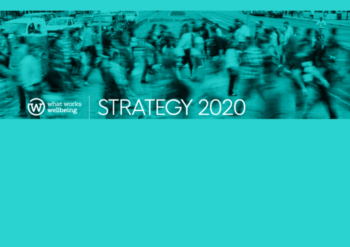
Our story
We are part of a ‘quiet revolution’ to improve wellbeing in the UK and reduce misery.
The Centre was established by the UK Prime Minister in response to the Commission on Wellbeing & Policy in 2014 to continue the implementation of the UK National Wellbeing Measurement Programme established in 2010. Whilst we have a global audience and partnerships, compiling the global knowledge base, our main focus is working with organisations in the UK to work out what works to improve wellbeing across our regions and nations.
Since 2014 we have worked with people and organisations from all sectors. We find out what works to protect and improve wellbeing for whom, when, where, why, and how. And then put evidence into action.
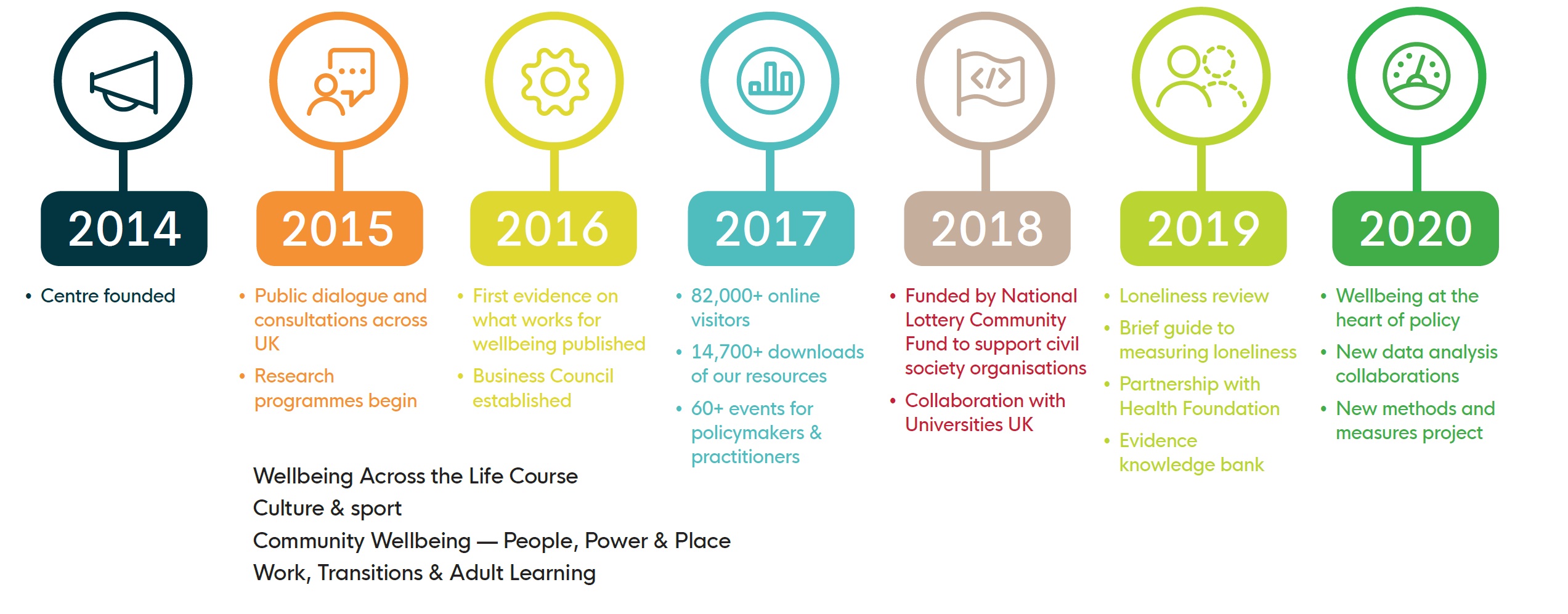
What we're aiming to achieve
Our mission is to develop and share robust, accessible and useful evidence that governments, businesses, communities and people use to improve wellbeing across the UK.
We are building an evidence system for wellbeing.
Our role:
- Establish the global evidence base.
- Get that knowledge to people who can and do use it.
- Identify evidence gaps and work with people to fill them.
We are successful when:
- Wellbeing is recognised as a meaningful and measurable goal for decision makers.
- Wellbeing evidence is generated that is robust, meaningful and useful.
- Knowledge of what works reaches people who can and want to use it.
- More evidence-informed action taken, and more trials and studies are done which feed back into evidence base.
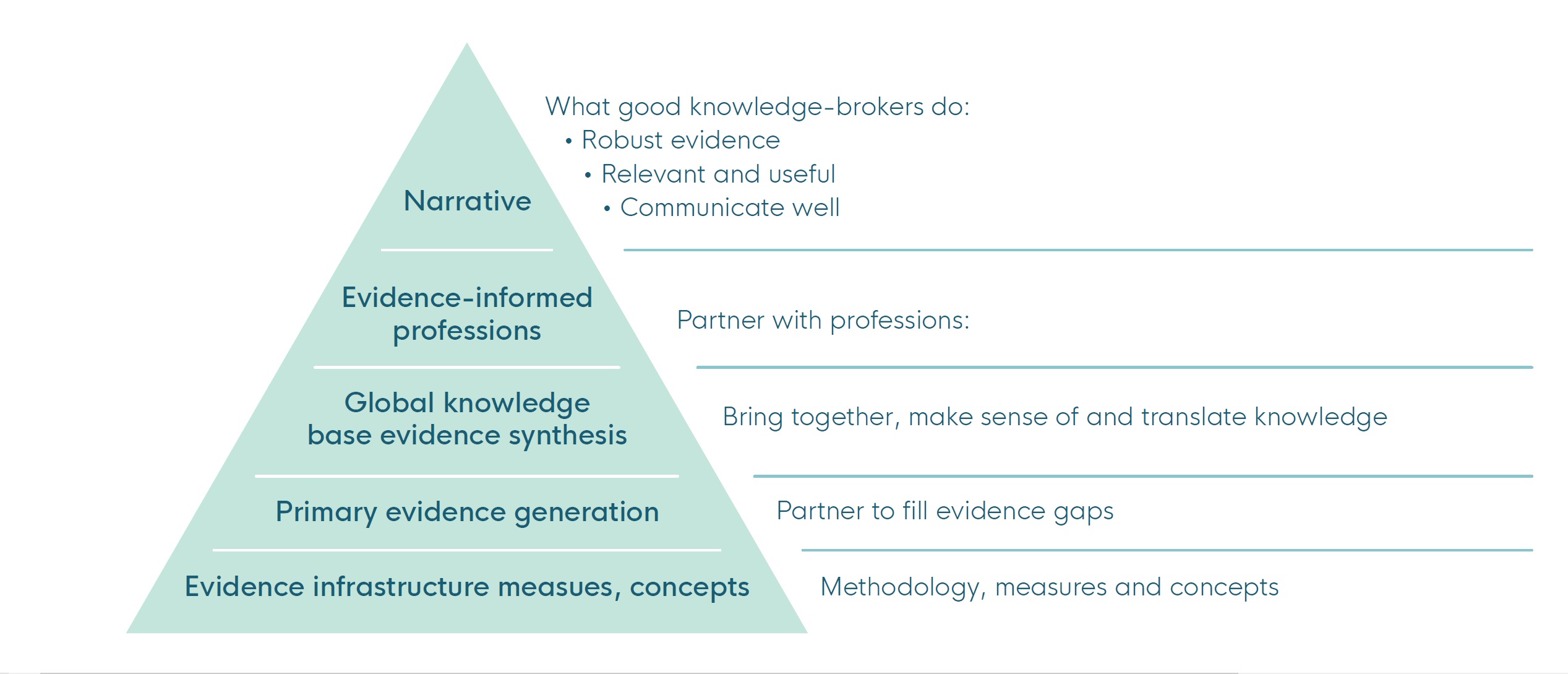
Wellbeing, done well
We aim to improve wellbeing in the UK, and reduce misery.
We do this through understanding what governments, business, communities, and people can do to improve wellbeing.
We are trusted, independent, evidence-based, collaborative, practical, iterative and open.
We are a public good.
We can work with you to understand:
- What do we know? And get that to people who can put it into action
- what don’t we know? And partner to find out.
Why?
- To avoid wasting time, effort, money and lives by doing well-meaning but less effective, even harmful things.
- To use what we already know.
- Learning as we go.
Our story, our impact
We reach over 12,000 people a month through our website alone with our digital-first delivery. This happens alongside a relational approach to change. It builds evidence of what works into systems, and develops capacity to add to, and act on, new learning.
Building on knowledge
Our approach is built on the knowledge of what works for research use, and the findings of our public dialogues that we pioneered to create a learning system for wellbeing.
Our focus
Wellbeing is broad and many organisations have a role to play. We are focused on where we think we can make the biggest difference to wellbeing in the UK as well as current expertise and networks.
We have also focused where there are relatively bigger evidence and implementation gaps that are not already being addressed by organisations with more resources where we will be a smaller partner:
- Connection & Community
Topics: places and community, loneliness, environment, culture, sports, arts, heritage, physical and mental health.
Social connections are consistently found to be strongest drivers of wellbeing, individually and collectively. There are big geographical differences in wellbeing in the UK. Emotional and self-perceived health are also strong drivers of wellbeing.
- Working age and business
Topics: work, education and learning, income and economy.
We are most miserable between the ages of 23 and 68. Employment has one of the largest effects on wellbeing. Yet, other than being ill in bed, we are most miserable when we’re at work with our managers. Money and basic need do matter, especially to those with relatively little.
- Methods, measures and concepts for wellbeing economics and analysis
This is a relatively new field where methodology such as the WELLBY are still developing. Our evidence reviews and work with policy & practitioners has shown the need to for greater consistency and comparability of measures and concepts. Using and understanding wellbeing data and measures. Developing methodology for use of wellbeing data and evidence in the field of decision making and wellbeing economics. Increasing use of comparable measures across sectors and disciplines.
We are also interested in being a supporting partner working on any of the following topics:
- Mental & physical health
- Financial security, debt & basic need
- Education & skills
- Built environment, local infrastructure, services
- Ecosystems & sustainability, natural environment
- Personal & partner relationships
- Arts & culture.
How we achieve our aims

The Centre’s Theory of Change is based on a major review of the evidence on knowledge mobilisation we commissioned with Wellcome Trust, working with the Alliance for Useful Evidence and EPPI-Centre at UCL, at the start of the Centre. It identified six mechanisms of knowledge use and looked at the evidence base behind them. It incorporates behavioural insights as pathways for the first time. Here is an overview of the findings.
The science of using science: what works in research use
This table sets out the evidence base on which our theory of change is based.
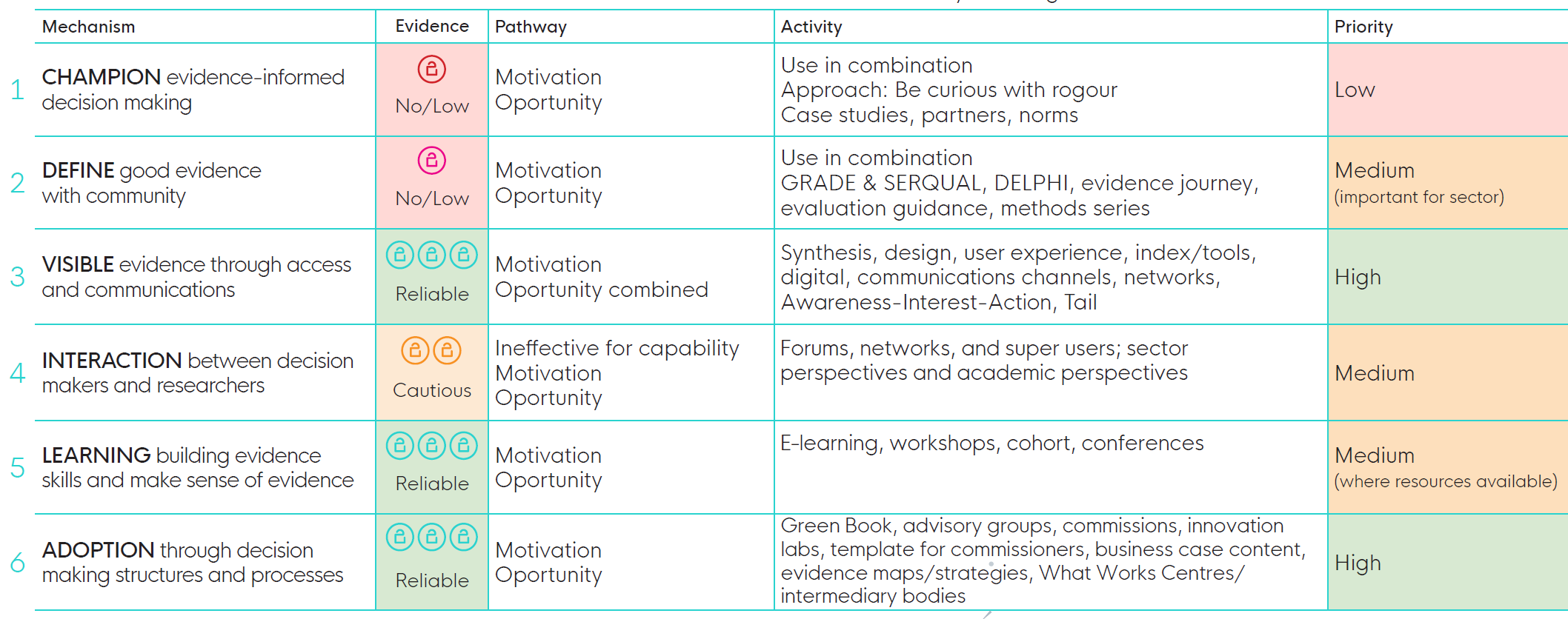
Our organisation
The What Works Centre for Wellbeing is part of the What Works Centre network and newly formed Evidence Quarter. The What Works Centres have been set up as independent centres with the aim to bridge between evidence, or knowledge, and practice for key decision-makers in the UK.
The aim is to improve the way Government and other organisations adopt and generate evidence for more effective decision-making. As a ‘knowledge-broker’ organisation and function as a bridge between
academia, policy and practice, ensuring the most robust and relevant evidence reaches the right audiences in the most accessible way.
Our structure and team
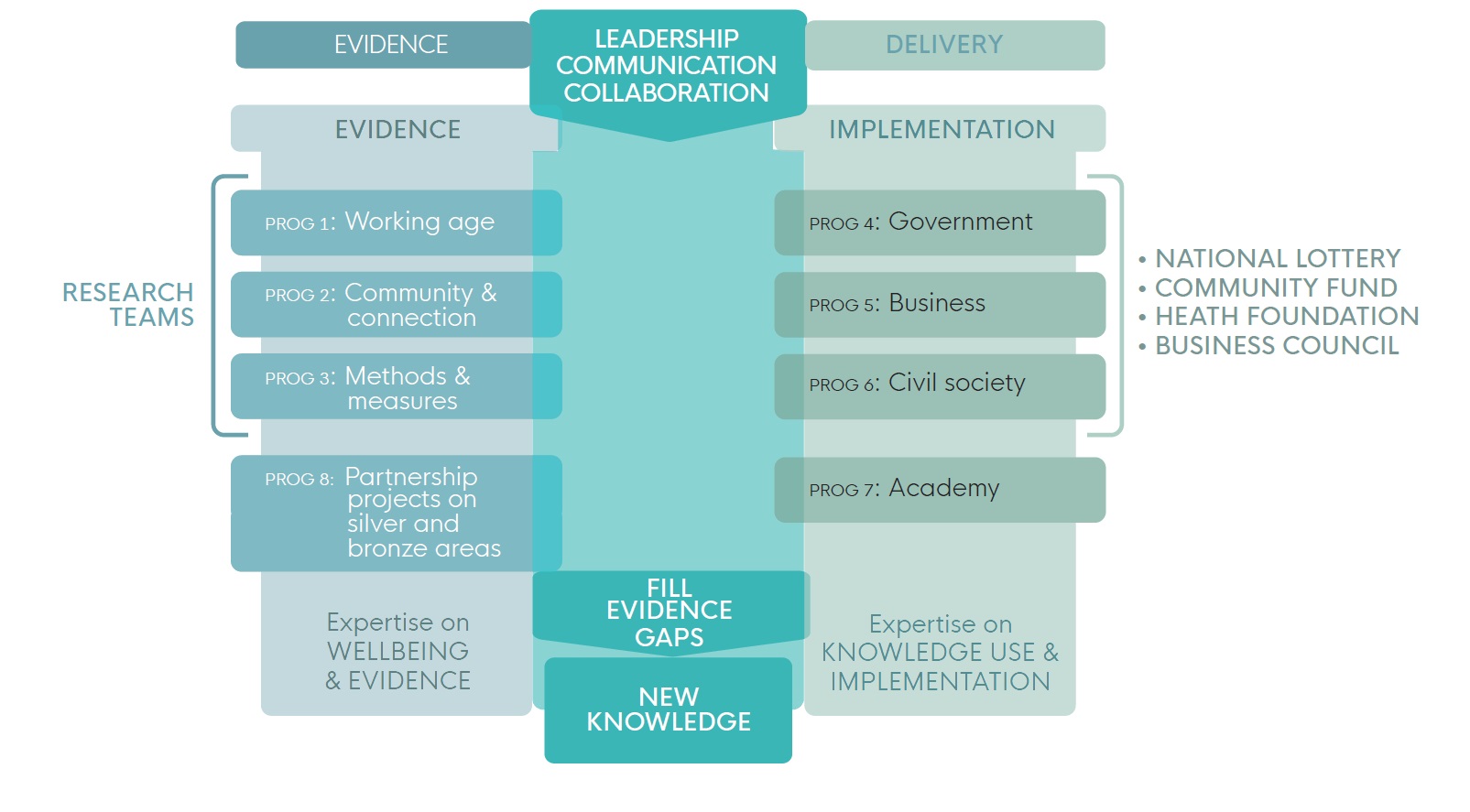
Current organisational priorities
Communications & Implementation Increase capacity and balance of the organisation on communications and implementation through partnerships and investment in new implementation leads.
We created online platforms, strengthened communication and networks such as the APPG Wellbeing Economics, and developed Civil Society & Local Government
Sector lead roles.
Research Partnership transition Transition from our four founding academic teams as part of our partnership with ESRC & AHRC to four new teams. We ended the first four year programme
publishing an update to the Commission on Wellbeing and Policy and the Knowledge Bank with all reviews.
Building capacity Growing the organisation to have its own commissioning and bidding functions as well as the capacity to deliver them. We created a new evaluation function and recruited a workplace analyst.
Relevant: Make wellbeing part of current Covid-19 recovery plans and beyond, For example through Business email series, Inequality email series and PHE Covid-19 impact toolkit and indicators.
Sustainable: Be an organisation that is fit for purpose in both funding and capacity. We are continuing to change the business model having built both commissioning and multi-sector bidding capability in-house.
Louder: Build a stronger voice through champions and visible organisations, partners and campaigns.
Expert: Proactively contributing to the fields of wellbeing, evidence, knowledge use and implementation through our What Works Network and Evidence Quarter Partners.
Impact: Continue to build on our current evaluation policy, and evaluation of the Centre by the Economic and Social Research Council, to better measure outcomes and impact.
How our priorities have evolved
Below are the Centre’s priority areas for previous years.
Communications & Implementation: Increase capacity and balance of the organisation on communications and implementation through partnerships and investment in new implementation leads. We created online platforms, strengthened communication and networks such as the APPG Wellbeing Economics, and developed Civil Society & Local Government Sector lead roles.
Research partnership transition: Transition from our four founding academic teams as part of our partnership with ESRC and AHRC to four new teams. We ended the first four year programme
publishing an update to the Commission on Wellbeing and Policy and the Evidence knowledge bank BETA with all reviews.
Building capacity: Growing the organisation to have its own commissioning and bidding functions as well as the capacity to deliver them. We created a new evaluation function and recruited a workplace analyst.
Our governance
Our audience is built into our governance and the way we work. This means deep sector knowledge and networks are embedded in our Board and Advisory Panel.
The aim is to ensure our work is:
a) robust & credible
b) relevant & useful
c) communicated well.
Board
The What Works Centre for Wellbeing is led by a board of voluntary Directors. The board is the ultimate decision maker, as outlined in the Articles of Association. The Board is responsible for working closely with the Executive Director and the senior management team to develop and agree a strategy for the organisation, and ensure that:
a) any activities and executive decisions are made in the best interest of the organisation, its stakeholders and the wider public
b) any activities and executive decisions contribute to achieving the organisational purpose and aims
c) that these are delivered effectively and sustainably.
Advisory panel
The Centre has an advisory panel that ensures quality assurance and suitability of the products and research outputs that are being produced. Quality assurance is to ensure robustness and improve relevance and accessibility. The Advisory Panel is composed of voluntary members who represent the key sectors and audiences the Centre engages with.
These include evidence and/ or wellbeing experts, researchers and academics, members of the original commissioning group, practitioners and decision-makers. The main purpose of this panel is to ensure high quality, transparency, relevance and accessibility of all the Centre’s products and research strategies. This group also serves to mitigate risks and manage disagreements or disputes around methodology, measures or theoretical approaches used during the evidence synthesis and translation.
Downloads
You may also wish to read the blog article on this document.
Downloads
You may also wish to read the blog article on this document.
![]()
[gravityform id=1 title=true description=true ajax=true tabindex=49]
